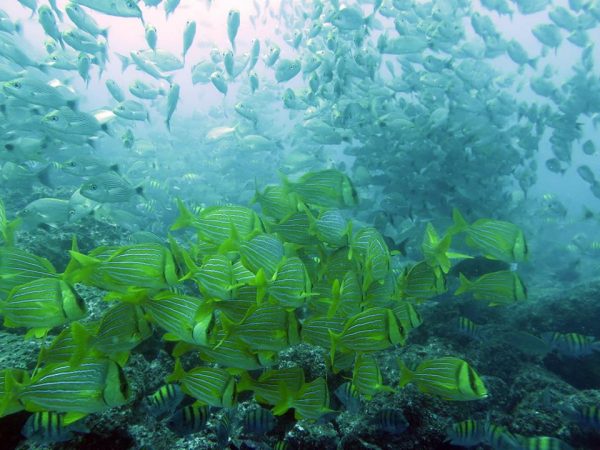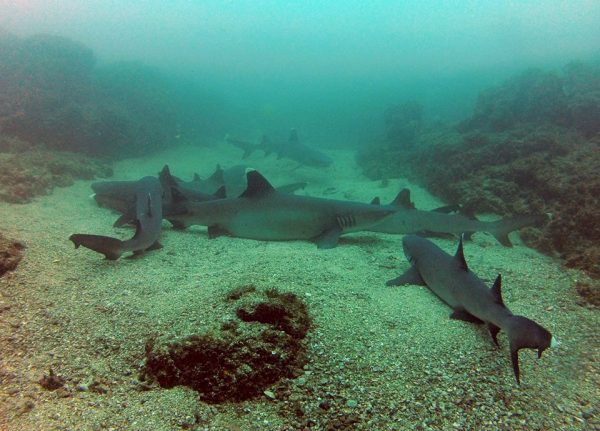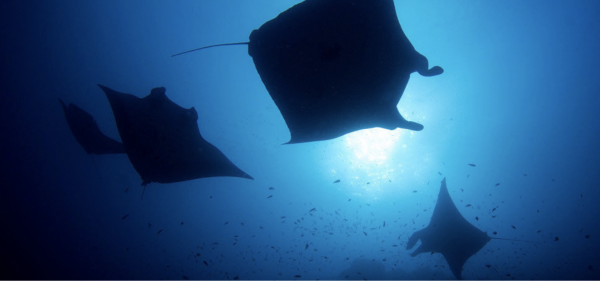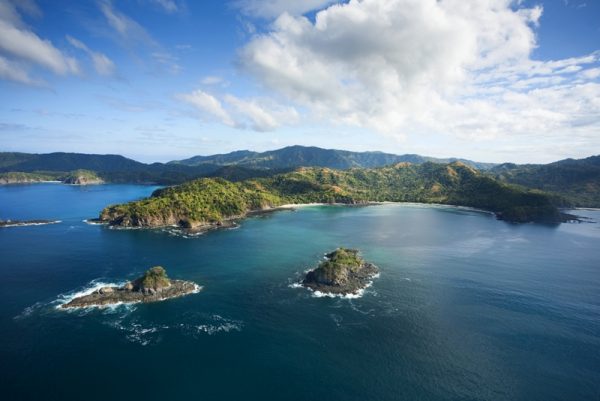Tuesday, November 5th, 2019.
In this Daily: Scuba Diving in Costa Rica and Departing from Your Front Door
Costa Rica has 10 times more marine area than it does landmass, and is home to a large biodiversity of fish that dwell in its open oceans, inshore coastlines, and mangroves. From the North Pacific Coast to the seas of the Osa Peninsula and across to the Caribbean, this wealth of aquatic life makes it possible to base an entire ecotour in Costa Rica around oceanic experiences.
Guanacaste in particular is home to some world-renowned dive sites, protected National Marine Parks, and a wide variety of animals like whales, dolphins, sea turtles, manta rays, white-tip reef sharks and bull sharks, as well as plentiful reef fish of many shapes and sizes.
 Plentiful schools of curious fish gather at Dirty Rock, surrounding divers in a living cloud of color
Plentiful schools of curious fish gather at Dirty Rock, surrounding divers in a living cloud of color
In Las Catalinas, the natural world in the waters of Guanacaste is at your doorstep. The bay just off of Playa Danta provides the opportunity to depart from the beach in a kayak to tour four vibrant snorkel sites, or swim there yourself. Just down the coast are the mangroves of Las Baulas National Park, and the beaches of the Ostional Wildlife Reserve, which host the massive arribadas of thousands of Olive Ridley Sea Turtles.
Las Catalinas is also a central hub to dive sites like the Catalinas Islands, Dos Sombreros, Dirty Rock and many more.
Door to Dive in the Guanacaste Waters
Aside from a wide variety of reef fish, migratory open ocean fish, and large schools of smaller rays, the dive sites of Guanacaste are notable as a primary habitat for whitetip reef sharks. Ranging from around 1ft long as pups to up to 5ft long as adults, whitetips are found either solo or in groups that can range up to seven or more individuals, and use the waters around the Catalinas Islands as a place to rest and find food.
 A group of whitetip reef sharks
A group of whitetip reef sharks
These waters are also ideal to encounter oceanic giant manta rays, the largest ray in the world at up to 23ft from wingtip to wingtip. Oceanic giant mantas are circumglobal and can be found throughout the world in tropical waters, but the waters from the Catalinas Islands to Bahía de Potrero are a common gathering point during manta migrations, and rays are especially prominent from the months of November to May.
 A school of oceanic giant manta rays
A school of oceanic giant manta rays
Staying in Las Catalinas presents the opportunity to depart right from the beach at Playa Danta and visit the many dive sites in the area in less than a thirty minute boat ride, going door to diving as little as an hour without ever needing to get into a car. Instead, the whole trip takes place walking, swimming, and out on the water.
ConnectOcean, the aquatic academy and dive center in Las Catalinas, are the local experts on these islands and dive sites. As one of their main goals, they are working to get the Las Catalinas Archipelago designated as a Marine Protected Area to preserve the area for generations to come, which includes extensive research in the area, and inviting visitors to explore the underwater environment.
The ConnectOcean team provides assistance throughout a dive trip to make it easy to immerse in the natural world under the water. The team tests all wetsuit and BC sizes the day before, and brings all gear including regulators and cylinders to the marina in the morning. All divers have to do is walk to the beach, swim out to the sea platform, hop aboard the boat as it arrives, and set out for the dive sites. Visitors who prefer to ride from the marina can do so as well.
Once aboard, the dive sites in the area include the Catalinas Islands, Dos Sombreros, Dirty Rock, and several other unnamed sites. All are within 10km from the beach, offering access to all of the area’s sites in about the time it takes to settle in, make introductions to crew, brief for the dive, and then get suited up.
Diving is an experience that provides a connection to nature and the outdoors, and an immersion in the ocean. When diving from Las Catalinas, removing the car ride changes the dynamic of the trip, meaning that door to dive site take place in the open air surrounded by the waves and the beauty of the Guanacaste coast.
 An aerial view of coast of Guanacaste
An aerial view of coast of Guanacaste
Dive from Las Catalinas
ConnectOcean has a number of different programs, which include a range of Citizen Science dives to track whitetips and giant mantas using laser photogrammetry, as well as training for everyone from beginners to master divers, starting from Discover Scuba and Open Water Certifications and reaching all the way to Dive Master and Dive Instructor training.
Whether visiting to learn more about diving or simply looking to discover Costa Rica’s underwater world, each dive helps contribute to the development of a sanctuary for Costa Rica’s aquatic life.
Combined with the ability to go from door to dive site without ever entering a car, diving from Las Catalinas is a chance to pursue a lifelong passion or discover a new one, all while immersed in one of the world’s most biodiverse places.
[maxbutton id="1" url="https://cta-redirect.hubspot.com/cta/redirect/4917861/bb90976c-fd33-457a-a285-892e384bad66" text="Dive Next Time You're Here" ]